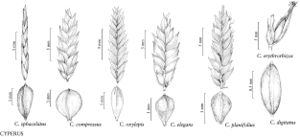Difference between revisions of "Cyperus oxylepis"
Syn. Pl. Glumac. 2: 25. 1855.
FNA>Volume Importer |
imported>Volume Importer |
||
| (2 intermediate revisions by 2 users not shown) | |||
| Line 6: | Line 6: | ||
|place=2: 25. 1855 | |place=2: 25. 1855 | ||
|year=1855 | |year=1855 | ||
| + | }} | ||
| + | |special_status={{Treatment/ID/Special_status | ||
| + | |code=I | ||
| + | |label=Introduced | ||
| + | }}{{Treatment/ID/Special_status | ||
| + | |code=F | ||
| + | |label=Illustrated | ||
}} | }} | ||
|basionyms= | |basionyms= | ||
| Line 23: | Line 30: | ||
|elevation=0–100 m | |elevation=0–100 m | ||
|distribution=Ark.;Fla.;Ga.;La.;Miss.;S.C.;Tex.;Mexico;South America. | |distribution=Ark.;Fla.;Ga.;La.;Miss.;S.C.;Tex.;Mexico;South America. | ||
| + | |introduced=true | ||
|discussion=<p><i>Cyperus oxylepis</i> is easily recognized by its sticky leaves, culms, and bracts (in living plants), involute leaves,and golden brown spikelets. The ovate-lanceolate floral scales and the ellipsoid, brownish achene with a persistent beak distinguish <i>C. oxylepis</i> from other species with deciduous floral scales.</p> | |discussion=<p><i>Cyperus oxylepis</i> is easily recognized by its sticky leaves, culms, and bracts (in living plants), involute leaves,and golden brown spikelets. The ovate-lanceolate floral scales and the ellipsoid, brownish achene with a persistent beak distinguish <i>C. oxylepis</i> from other species with deciduous floral scales.</p> | ||
|tables= | |tables= | ||
| Line 46: | Line 54: | ||
|publication title=Syn. Pl. Glumac. | |publication title=Syn. Pl. Glumac. | ||
|publication year=1855 | |publication year=1855 | ||
| − | |special status= | + | |special status=Introduced;Illustrated |
| − | |source xml=https:// | + | |source xml=https://bitbucket.org/aafc-mbb/fna-data-curation/src/2e0870ddd59836b60bcf96646a41e87ea5a5943a/coarse_grained_fna_xml/V23/V23_282.xml |
|genus=Cyperus | |genus=Cyperus | ||
|subgenus=Cyperus subg. Cyperus | |subgenus=Cyperus subg. Cyperus | ||
Latest revision as of 20:39, 5 November 2020
Herbs, perennial, cespitose, coarse, (culms, leaves, bracts, and rays viscid). Culms roundly trigonous, 10–50 cm × 0.9–2.4 mm. Leaves: adaxial face concave, becoming flat to trigonous apically, 10–46 cm × 1.5–4 mm, margins involute. Inflorescences: spikes ovoid, 1–5.5 cm wide; rays usually 3–6, 0.5–5 cm, glabrous; sometimes absent in small plants; if absent, inflorescence a congested head of spikelets 1–3.5 cm diam.; 2d order rays 0–3, 1–3 cm; bracts 3–5, vertical to ascending at 45°, 2.5–25 cm × 1.2–4 mm, margins involute; 2d order bracts 0–2, 5–20 mm; rachilla persistent, wingless. Spikelets 5–24, greenish yellow to golden brown, oblong to linear-lanceoloid, quadrangular, strongly compressed, 7–20(–30) × 2.5–4(–6) mm; floral scales 10–20(–40), spreading, pale green to stramineous, laterally 2–3-ribbed, ovate-lanceolate, 3.1–4 × 1.5–2.4 mm, apex with mucro 0.2–0.8 mm. Flowers: anthers 0.6–0.8 mm; styles 0.8–1.6 mm; stigmas 1–1.4 mm. Achenes light to dark brown, rarely somewhat reddish, stipitate, ellipsoid, 2–2.4 × 0.5–0.8 mm, base cuneate, stipe whitish, spongy, 0.2–0.3 × 0.2–0.4 mm, apex acute, persistent style forming beak 0.5–1.2 mm, surfaces glabrous or finely papillose.
Phenology: Fruiting summer.
Habitat: Ditches and disturbed places in marshes, often in saline soil
Elevation: 0–100 m
Distribution

Introduced; Ark., Fla., Ga., La., Miss., S.C., Tex., Mexico, South America.
Discussion
Cyperus oxylepis is easily recognized by its sticky leaves, culms, and bracts (in living plants), involute leaves,and golden brown spikelets. The ovate-lanceolate floral scales and the ellipsoid, brownish achene with a persistent beak distinguish C. oxylepis from other species with deciduous floral scales.
Selected References
None.
